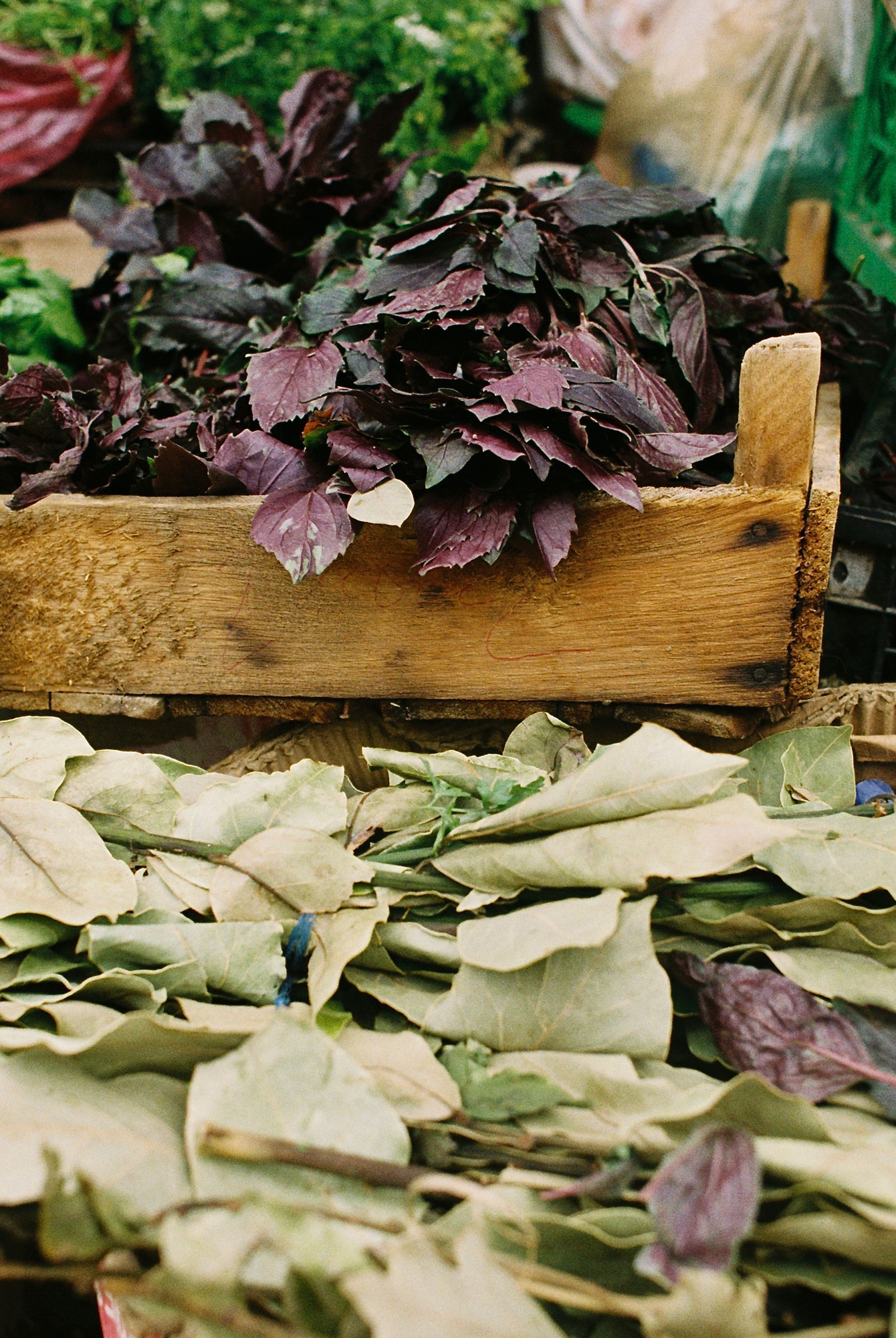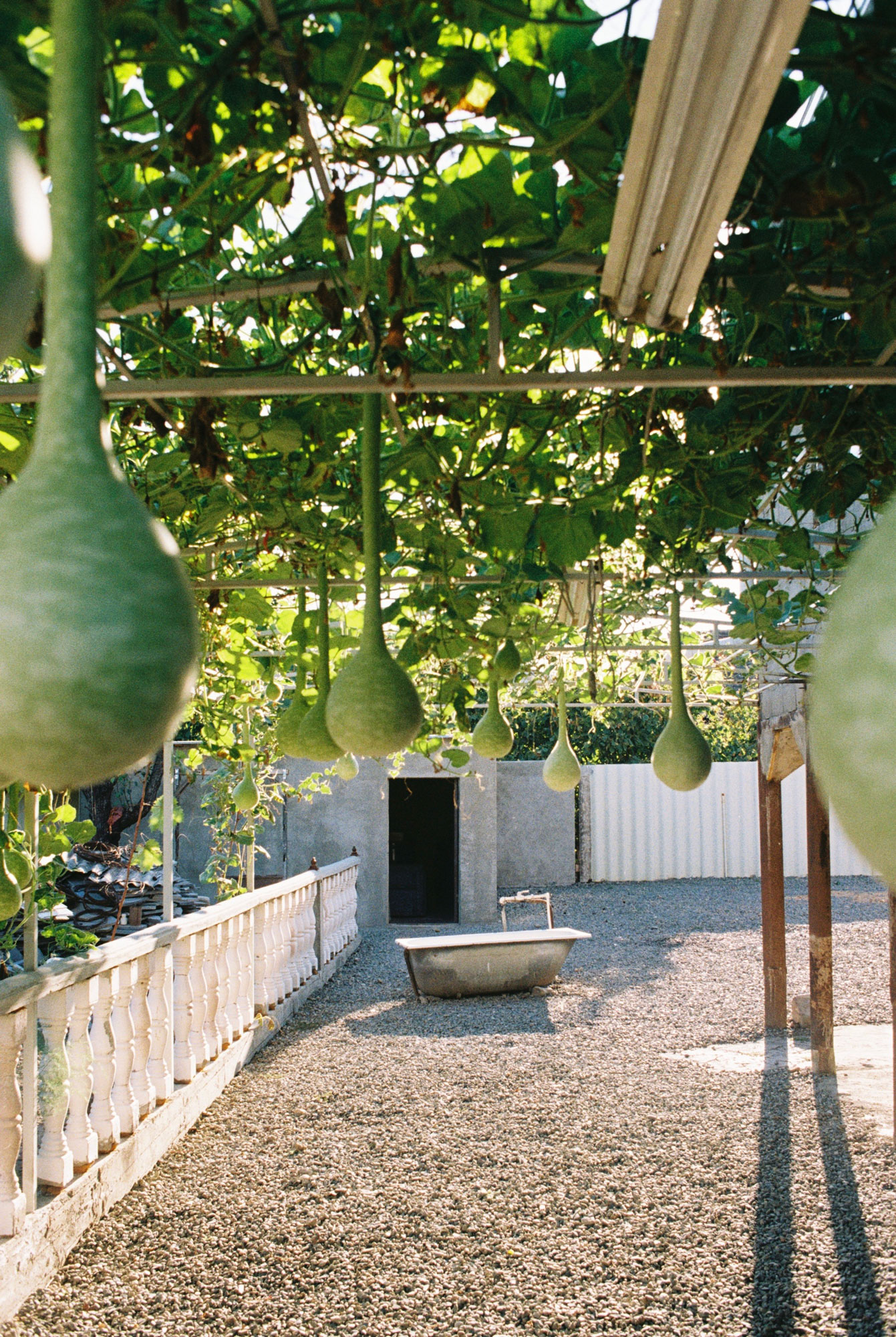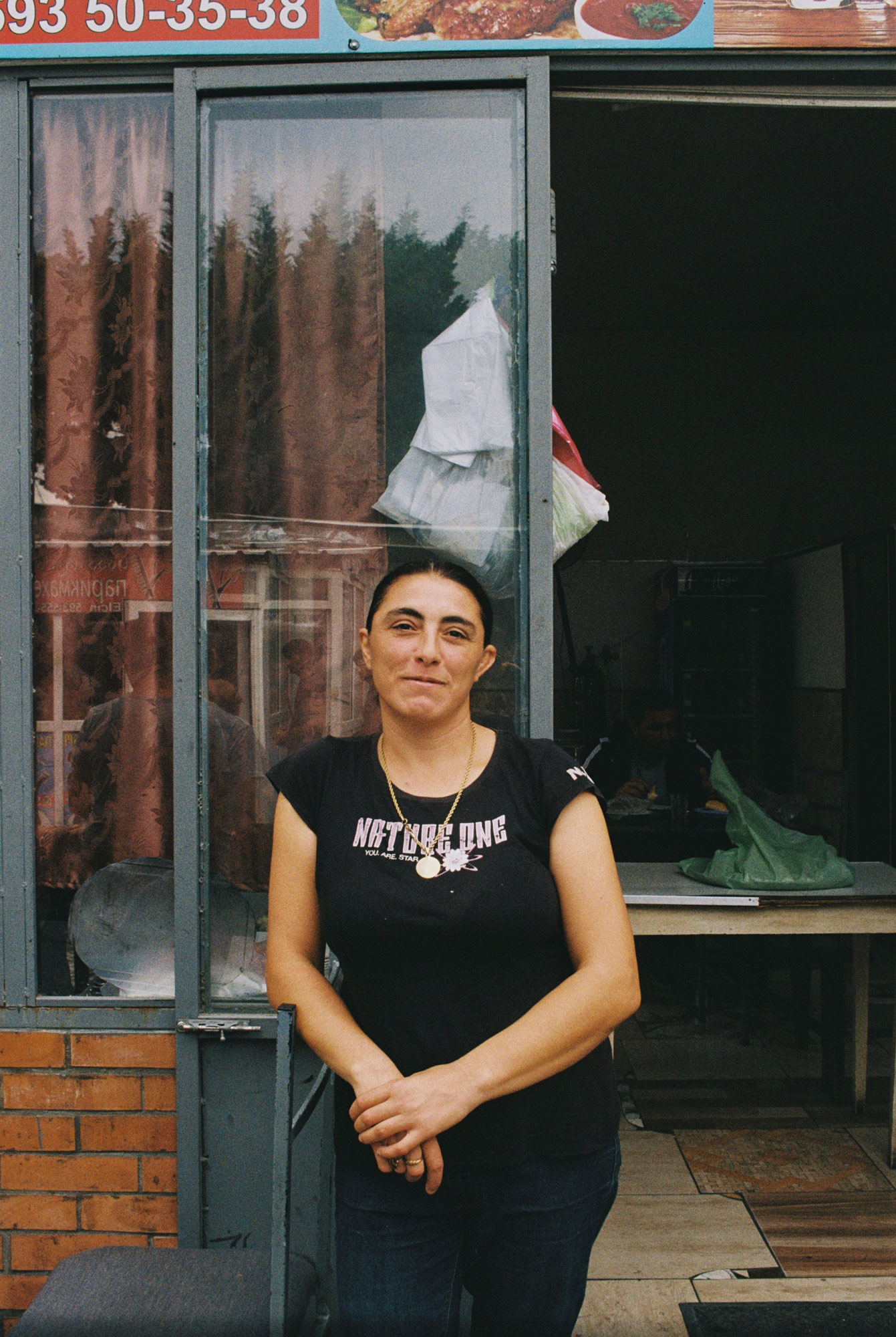Tracing Common Spaces
by Corten Perez-Houis, Kirill Repin, Sopiko Rostiashvili, Marie-Luise Schega Hermine Virabian
A chaikhana in Marneuli Bazaar (2022), by Marie-Luise Schega
Every being leaves a trace. One does not even have to do anything, simply be in order to alter and be altered in interrelation with (an)other. The scale of trace-making skyrockets if we hone in on human existence in the age of anthropocentric climate change. Of course, that story is as complex as our species. We know our footprints are too large for this planet to survive. We also know that in order to survive, we need to be noticed and acknowledged by our fellow earth dwellers. Most of us want to be remembered, somehow, by someone.
During our visits to Marneuli Bazaar and Shulaveri village, both significant due to their co-existing Georgian, Armenian and Azerbaijani populations, our group paid attention to physical, social, emotional and historical traces. The unspoken borders, relational stories, daily routines, smells and tastes. The present and the absent.
By being there, clearly visibly non-locals, we left traces ourselves. With the money we spent and the money we didn’t spend, thanks to people’s unwavering hospitality. Through the stories we exchanged and the stories we couldn’t exchange due to language barriers. We observed and were being observed; we documented with our cameras, pens and papers, and were in turn subjects of local gossip. We became each other’s memories.
Being an inherently complex species also means we are masters of over-simplification, especially when faced with temporal constraints. Our experience during the field school was no different. What we present here are selected representations of the traces we recorded and interpreted over the course of three days, according to our personal backgrounds, skills and interests.
A small note on methodological abduction
by Kirill Repin
How to capture unknown space without imposing an artificial matrix of superfluous boundaries and arbitrary divisions? The question of objectivity – uncomfortable in its own right – looms even larger, when posed for and by a group of foreigners, aiming to grasp a local context under the conditions of extreme time pressure, as in the case of the summer school.
With all the fieldwork squeezed into hours, that hardly exceed one full day in their entirety, the only refuge that seems to remain is epistemic humility – a humble acknowledgment that the space will inevitably elude our attempts to encompass it in its completeness. Thus, it is through emptiness that we decide to proceed, emptiness full of traces.
This task becomes clear in the haunting solitude of the main market hall at Marneuli bazar. Built some 10-15 years ago to put all the vendors of local produce under one roof, it had to be vacated with the start of the pandemic in 2020 for the sake of health security, and now stands full of absence. Or rather, as it quickly starts to appear, filled with the presence of somebody’s absence.
From here we slide along the crooked geometry of the market, following the logic of abduction – letting the space mesmerise us and lead us away from ourselves. We are looking for something we don’t know – finding traces and letting traces find us. In a dizzying polyvocality, the space suddenly starts to expand beyond the boundaries of the Marneuli market and a trace becomes the lowest common denominator for this multidimensional geometry that reveals itself to us.
Hints turn into signs, as we encounter (or intrude?) stories spawn out of the webs of connections, relations, phrases and languages, products and objects, subjects and species, co-inhabiting this space in their simultaneity. We explore it in a vernacular way, relying on the stories we hear about how the common life in the past was easier than it is in the present. How the nearby countries, better-off economically, is a place to go, but eventually, also a place to return from. How the closure of borders during the pandemic has significantly shrunk the turnover off the market – the centre of local economic activity. How multilingualism and mutual respect are mundanely practised in the present – something that still makes this present somewhat easy to share.
Caught between vernacular phenomenology and phenomenology of the vernacular, we look, hear and disperse in different directions, in order to meet later together again in one of the market chaikhanas to share a common meal. We complete our own circle(s), contemplating how while looking for traces, we let the space leave traces in ourselves. In an enticing way our maps, notes and sketches, photos and video footage invite us to treat them as a window onto the explored space. Alas, they can equally be just a mirror of our own gazes.
Looking at it, we recognize how our trajectories got inevitably entwined into the spatial fabric we have been trying to disentangle. Its geometrical pattern now extends through us as well and we have become actors in this incessant multidimensional spatial poiesis. Abduction doesn’t seem to have worked out completely…
Perhaps, this partial failure is simply part of it as a method– always leaving a chance of doubt, a certain degree of emptiness to step back and reconsider one’s own perspective, knowing that there is so much more to tell. Emptiness, that we have been trying to synchronise all along: in our improvised approach, in the space we have explored and within our own selves.
Mapping a common trading area
by Corten Perez-Houis
Marneuli Bazaar is an ancient regional trading hub for several products, such as vegetables, fruits and meat. It is constituted of different zones that can be defined by the architecture and organisation of the space (open air/ covered market), by the types of products sold (vegetables, dairy products, clothes) or by its history. The main open air area is surrounded by old garages, converted into warehouses and workshops after the collapse of the Soviet Union, whereas the Marneuli Mall, for example, is very recent (2017), as well as the massive covered market. It was built under Mikheil Saakashvili’s rule (2012) to host the vegetable and dairy sellers, but has been abandoned since the beginning of the Covid pandemic in 2020.
We approached the spatial and commercial organisation and its recent evolutions through mapping. Each person’s mapping took a different form – manual sketches, satellite images, computer- aided design – and happened at different intervals – during an interview, between two field visits, two weeks after our visits. The mapping gestures were often automatic, which can be explained by the different backgrounds of the participants, but also as a way to directly translate our visual observations on paper. These maps are the products of our observations, our perceptions of the place and our memories. Far from only trying to give an exact snapshot of the « reality » of Marneuli bazaar, they show our different approaches to this trading area and the traces that left a mark on us.
Hiding and Saving
by Sopiko Rostiashvili
Marneuli is a city in the Kvemo Kartli region, close to Tbilisi. Compared to the capital, however, it is significantly peripheral culturally, socially, politically, and urbanely. The perceived remoteness of the place and the non-material boundaries through which it is often defined, are conditioned, on the one hand, by the demographic structure of the local population: Marneuli is mainly populated by ethnic and religious minorities. On the other hand, despite representing an important economic region in Georgia, which supplies the whole country with agricultural goods, many of its inhabitants live in poverty and are exposed to strong social inequality. The symbolic distance between Marneuli and the Georgian capital thus seems farther than the geographical one.
Marneuli Bazaar is one of the most significant shared spaces of function and diversity. It is an important commercial center on the local, national, and international levels.
This bazaar supplies the city and the rest of the country with agricultural goods. It creates space for product exchange between Georgia, Armenia, and Azerbaijan connecting the three countries via a common food trade system. Hence, the space is very sensitive to changes. It reacts to policies and transformations in this borderland region. For example, academic research and sellers at the Marneuli Bazaar corroborate how the area is negatively affected by the COVID-related restrictions of cross-border movements. In some cases, the trading supply chain between these countries was simply lost.
The Marneuli bazaar is located in the city centre and covers a significant area. It includes a substantial bounded commercial space and the road which connects it to Rustaveli Street – the main street in Marneuli. This conjunctive road is voluntarily occupied by vendors. Most of the sales people here are Azerbaijanian villagers from the Marneuli region who sell goods from cars and minibuses on sidewalks. But you can find Kartlelian, Svani, or Armenian vendors, too. Indeed, the owner of the main commercial space is a Svani businessman.
The bazaar is divided by its varied assortments: agricultural goods, meat, cheese, first-hand and second-hand clothes, and shoes. Kabab houses and Chai-khanas are popular meeting places. All these products and services can be found in specific areas of the bazaar. Invisible boundaries sharply separate these functional spaces. Indeed, they do not cross over or mix with each other.
At the beginning of the bazaar, you can find the main bazaar, as locals call it, where clothes and meat are sold, and kabab houses and chai- khanas are located. People sell agricultural goods around this main bazaar space but not inside. The neighboring part is given to agricultural products and other small things.
A new market hall has been abandoned since the COVID-19 pandemic started in 2020, with the vendors moving out to the surrounding area. Interviews with some of them revealed why they prefer that way instead of moving back into the market hall: selling products outside is better because of fewer taxes and the lower possibility of spreading COVID.
Saving and hiding in Marneuli Bazaar
What does hiding or saving mean? And what is the difference between them? In this article, I define hiding as an act of making undesirable, shameful things invisible. Saving refers to temporarily storing valuable items for future consumption inconspicuously. In different contexts, these terms may be explained differently and have distinct meanings. From my perspective and within the context of our field work, these terms accurately capture the practices that can often be observed among the people in the Marneuli bazaar. Chaos and lack of organization are some of the first impressions while visiting the Marneuli bazaar. A considerable amount of trash attracted my attention. However, as I was exploring the space, I discovered that the existing chaos is indeed organized, and people who work there have their own strategies for dealing with trash. The example of the Marneuli bazaar shows that waste, as a specific object of shame and often a marker of social inequality and marginalisation, can result in the intention of making it “disappear,” i.e., dissolve into the background. Working in the field in Marneuli brought new patterns of using space into light. The administration’s and workers’ attitudes toward trash are apparent in a partly unseen way. From the city center to the main bazaar part, it is evident that the daily accumulated waste is cleaned up in an everyday routine.
Nevertheless, in the agricultural market, one can immediately recognize how rubbish gets accumulated over a long period of time. In this case, people start collecting waste following a specific pattern, conveying an attempt to hide it in an (in)conspicuous way. At the Marneuli bazaar, it is common for vendors to gather rotten vegetables, fruits, and other waste, accumulating them under trees, bushes, or walls of nearby buildings. As mentioned earlier, it seems that the approach makes accumulated trash as an annoying or unpleasant condition invisible. At first glance, there might even be a feeling that the waste is produced and owned by a plant or a location, not by vendors and their clients.
Hence, another question is raised: Why don’t these vendors clean up the rubbish by themselves? It isn’t possible to fully answer this question with the limited collected materials during our field work. It can only be speculated that, because this bazaar is a private place, local vendors don’t have a feeling of ownership over the space, which would perhaps motivate them to clean it.
Moreover, there is another hiding practice at Marneuli bazaar. Some vendors try to hide and make waste invisible by storing it behind their shop counters. In this case, the trash cannot be seen from the front, but only from the back.
Besides what is shameful and should be hidden, there are practices no less significant, like the practice of saving. Vanishing is a saving attempt, too, which vendors and customers implement at the same time.
During one of the days we visited the Marneuli bazaar, it was rainy and thus less favorable weather for local salespeople. That day, the practice of saving goods was particularly apparent. Local vendors of agricultural goods wrap their products in fabrics or, in the best case, a waterproof canvas. Sometimes one can also find things wrapped in curtains or even clothes, although this is a poor decision as it provides limited protection from the elements.
Customers have saving practices, too. During our exploration of the abandoned market hall, my colleagues and I found a wooden sheet attached to a table next to the wall. Behind this sheet, someone had saved the goods purchased at the bazaar. Although it wasn’t noticeable from the front, from the side we could see that someone stored the products there for a purpose. Interestingly, we didn’t see this stuff and the wooden sheet when we returned the next day.
In summary, the article explores the structure of the bazaar and shared practices of saving and hiding among vendors and customers at Marneuli Bazaar. First, the bazaar is a core economic and common space with clearly detached areas, if via invisible boundaries. Second, the hierarchy inside the bazaar impacts how waste management and people function (especially where vendors of agricultural goods are located on the streets surrounding the abandoned market). Two of the explored within these structures are saving and hiding.
Everyday practices of saving and hiding in this bazaar illustrate the following context: the prevalence of inequality. The local administration does not collect all the waste, which, over time, accumulates. This may be the reason why vendors started hiding practices. Moreover, inhabitants’ attitudes toward trash and the shame of co-existing with waste are apparent in the hiding practices within the context of the bazaar. These are primordial and naive practices, as much as the saving of goods for future consumption, which remain visible and are not protected properly. Finally, in Marneuli Bazaar everyday practices of hiding and saving are collectively shared and firmly established.
A feast for the eyes
photographed by Marie-Luise Schega (35mm film)
Visual traces of the raw, fresh, dried, growing, grown, harvested, forgotten, processed, prepared, packaged, consumed, decorative, surviving, discarded, mouldy, rotting, decomposing foods we encountered in Shulaveri and at Marneuli Bazaar.
Read more:
IN THE SEARCH FOR COMMON NARRATIVES
by Klaudia Kosicińska
“YOURS, SPACE”
Poem by Marie-Luise Schega & Film Stills by Hermine Virabian
SUPRA OF STORIES
by Jan Chrzan, Katya Krat & Nutsa Lomsadze
SHULAVERI
by Natavan Alieva
STORIES OF KIOSKS (PAST AND PRESENT OF SHAUMIANI)
by Ketevan Lapachi & Lala Iskandarli
The Sevda of Sadakhlo
by Ana Kvichidze, Catherine Steiner & Klara Böck
THE LIBRARY OF SHAUMIANI
by Juri Wasenmüller





